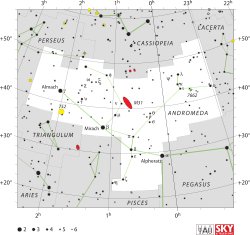60 Andromedae

| |
| Observation data Epoch J2000 Equinox J2000 | |
|---|---|
| Constellation | Andromeda |
| Right ascension | 02h 13m 13.32387s[1] |
| Declination | +44° 13′ 53.9546″[1] |
| Apparent magnitude (V) | +4.82[2] |
| Characteristics | |
| Spectral type | K3.5 III Ba0.4[3] |
| U−B color index | +1.74[2] |
| B−V color index | +1.48[2] |
| Astrometry | |
| Radial velocity (Rv) | –46.3[4] km/s |
| Proper motion (μ) | RA: –20.90[1] mas/yr Dec.: –14.46[1] mas/yr |
| Parallax (π) | 6.15 ± 0.63[1] mas |
| Distance | approx. 530 ly (approx. 160 pc) |
| Orbit[5] | |
| Period (P) | 748.2±0.4 days |
| Semi-major axis (a) | 3.0±2.6" |
| Eccentricity (e) | 0.34±0.03 |
| Inclination (i) | 127±15° |
| Longitude of the node (Ω) | 6±17° |
| Periastron epoch (T) | 37886±11 HJD |
| Argument of periastron (ω) (secondary) | 358±6° |
| Details | |
| 60 And A | |
| Mass | 2.0+0.7 −0.3[5] M☉ |
| Surface gravity (log g) | 1.70±0.44[6] cgs |
| Temperature | 4054±42[6] K |
| Metallicity [Fe/H] | −0.13±0.12[6] dex |
| 60 And B | |
| Mass | 0.5±0.1[5] M☉ |
| Other designations | |
60 Andromedae (abbreviated 60 And) is a star system in the northern constellation of Andromeda, located to the west-northwest of Gamma Andromedae. 60 Andromedae is the Flamsteed designation though the star also bears the Bayer designation b Andromedae. It is bright enough to be seen by the naked eye with an apparent visual magnitude of 4.82.[2] Based upon parallax measurements made during the Hipparcos mission, it is at a distance of roughly 530 light-years (160 parsecs) from Earth.[1]
This system is known to have three components. The primary is a giant star with a stellar classification of K3.5 III Ba0.4. It is being orbited by a white dwarf with a period of 748.2 days and an eccentricity of 0.34. There is a third component at an angular separation of 0.22 arcseconds.[3]
References
- 1 2 3 4 5 6 van Leeuwen, F. (November 2007), "Validation of the new Hipparcos reduction", Astronomy and Astrophysics, 474 (2): 653–664, arXiv:0708.1752
 , Bibcode:2007A&A...474..653V, doi:10.1051/0004-6361:20078357.
, Bibcode:2007A&A...474..653V, doi:10.1051/0004-6361:20078357. - 1 2 3 4 Argue, A. N. (1966), "UBV photometry of 550 F, G and K type stars", Monthly Notices of the Royal Astronomical Society, 133: 475–493, Bibcode:1966MNRAS.133..475A, doi:10.1093/mnras/133.4.475.
- 1 2 Eggleton, P. P.; Tokovinin, A. A. (September 2008), "A catalogue of multiplicity among bright stellar systems", Monthly Notices of the Royal Astronomical Society, 389 (2): 869–879, arXiv:0806.2878
 , Bibcode:2008MNRAS.389..869E, doi:10.1111/j.1365-2966.2008.13596.x.
, Bibcode:2008MNRAS.389..869E, doi:10.1111/j.1365-2966.2008.13596.x. - ↑ Wilson, Ralph Elmer (1953), General Catalogue of Stellar Radial Velocities, Washington: Carnegie Institution of Washington, Bibcode:1953GCRV..C......0W.
- 1 2 3 Pourbaix, D.; Boffin, H. M. J. (February 2003), "Reprocessing the Hipparcos Intermediate Astrometric Data of spectroscopic binaries. II. Systems with a giant component", Astronomy and Astrophysics, 398: 1163–1177, arXiv:astro-ph/0211483
 , Bibcode:2003A&A...398.1163P, doi:10.1051/0004-6361:20021736.
, Bibcode:2003A&A...398.1163P, doi:10.1051/0004-6361:20021736. - 1 2 3 Koleva, M.; Vazdekis, A. (February 2012), "Stellar population models in the UV. I. Characterisation of the New Generation Stellar Library", Astronomy & Astrophysics, 538: A143, arXiv:1111.5449
 , Bibcode:2012A&A...538A.143K, doi:10.1051/0004-6361/201118065.
, Bibcode:2012A&A...538A.143K, doi:10.1051/0004-6361/201118065. - ↑ Tirion; Rappaport; Lovi (1987). Willmann-Bell, Inc., ed. Uranometria 2000.0 - Volume II - The Southern Hemisphere to +6°. Richmond, Virginia, USA. ISBN 0-943396-15-8.